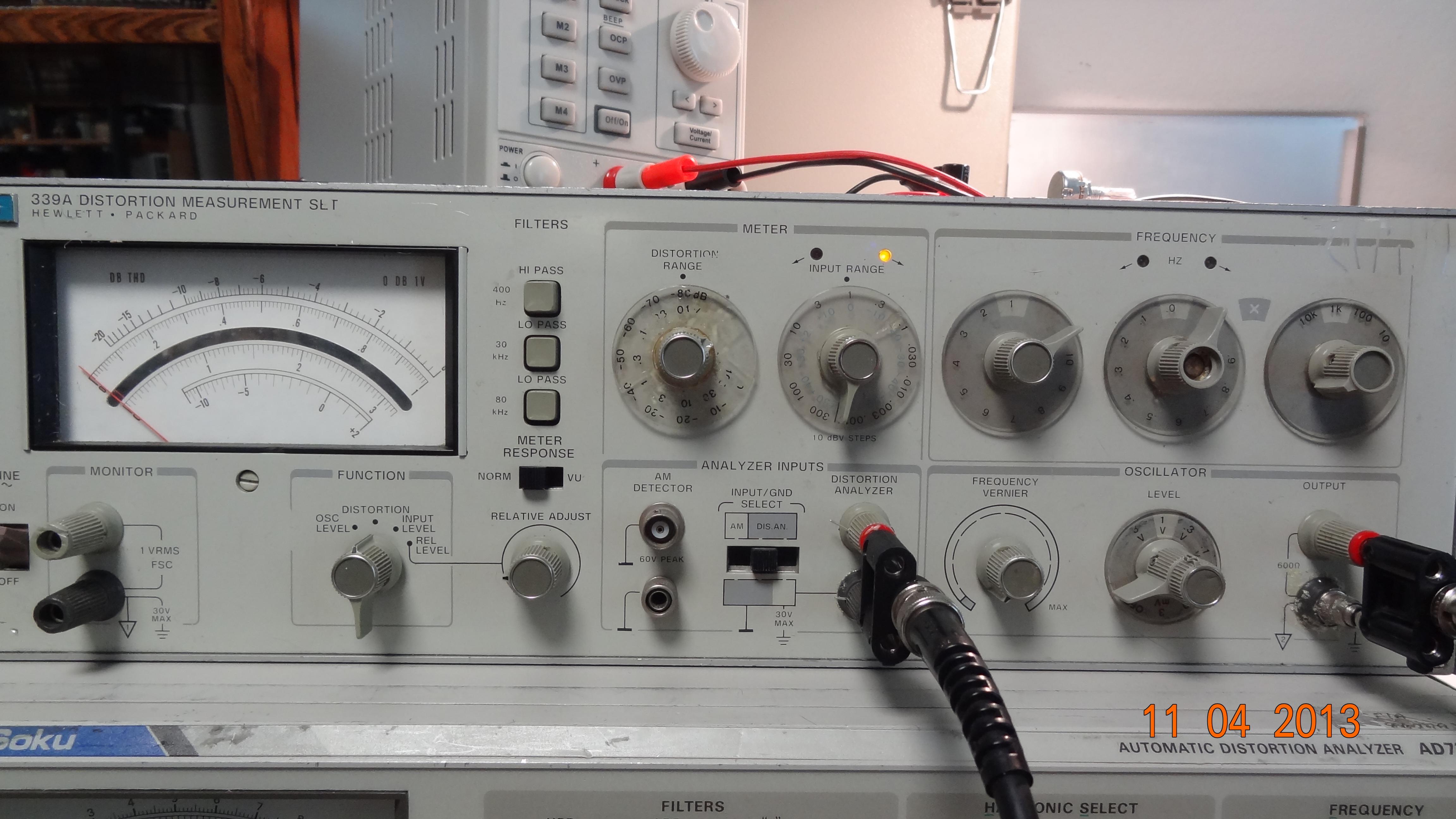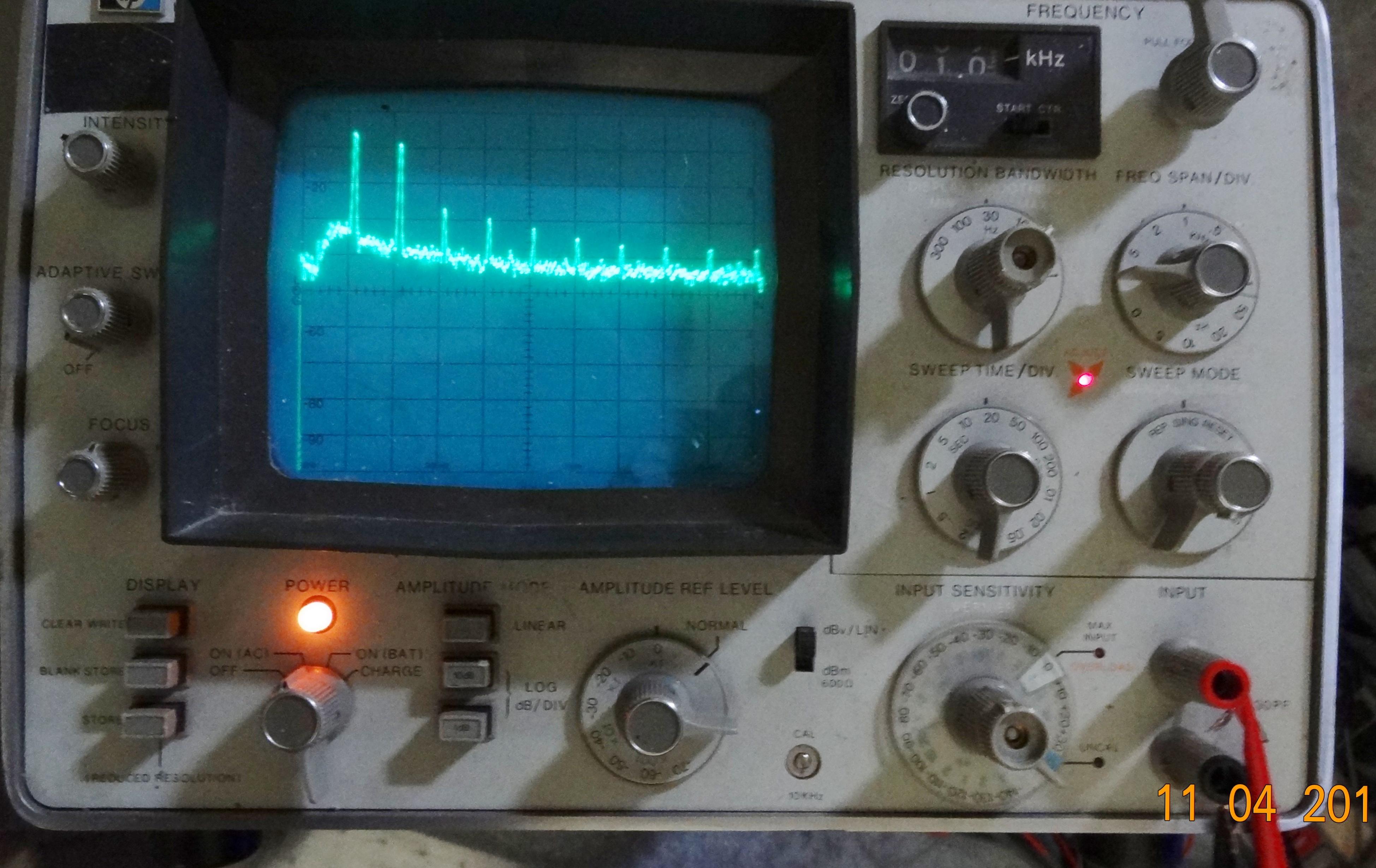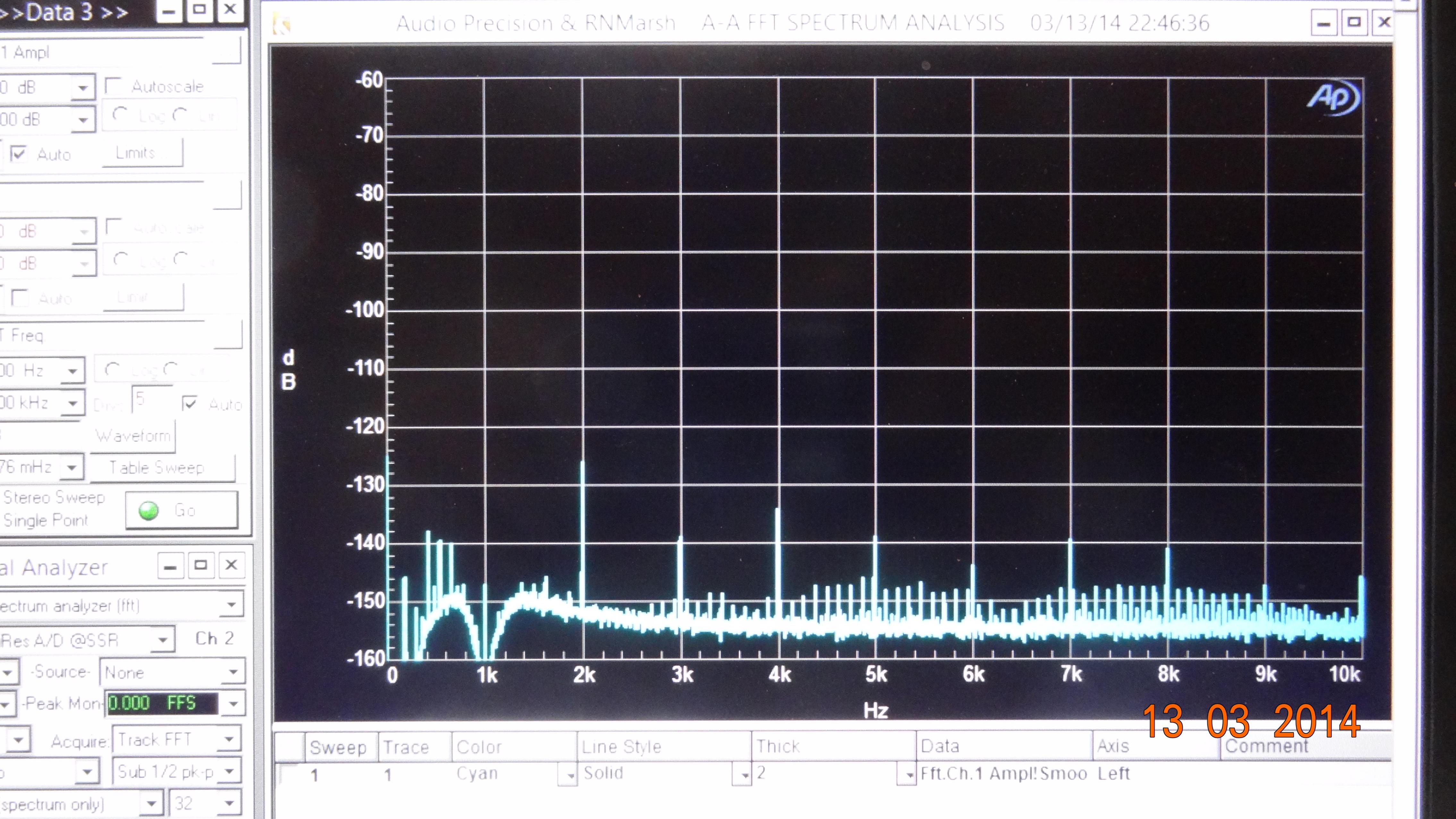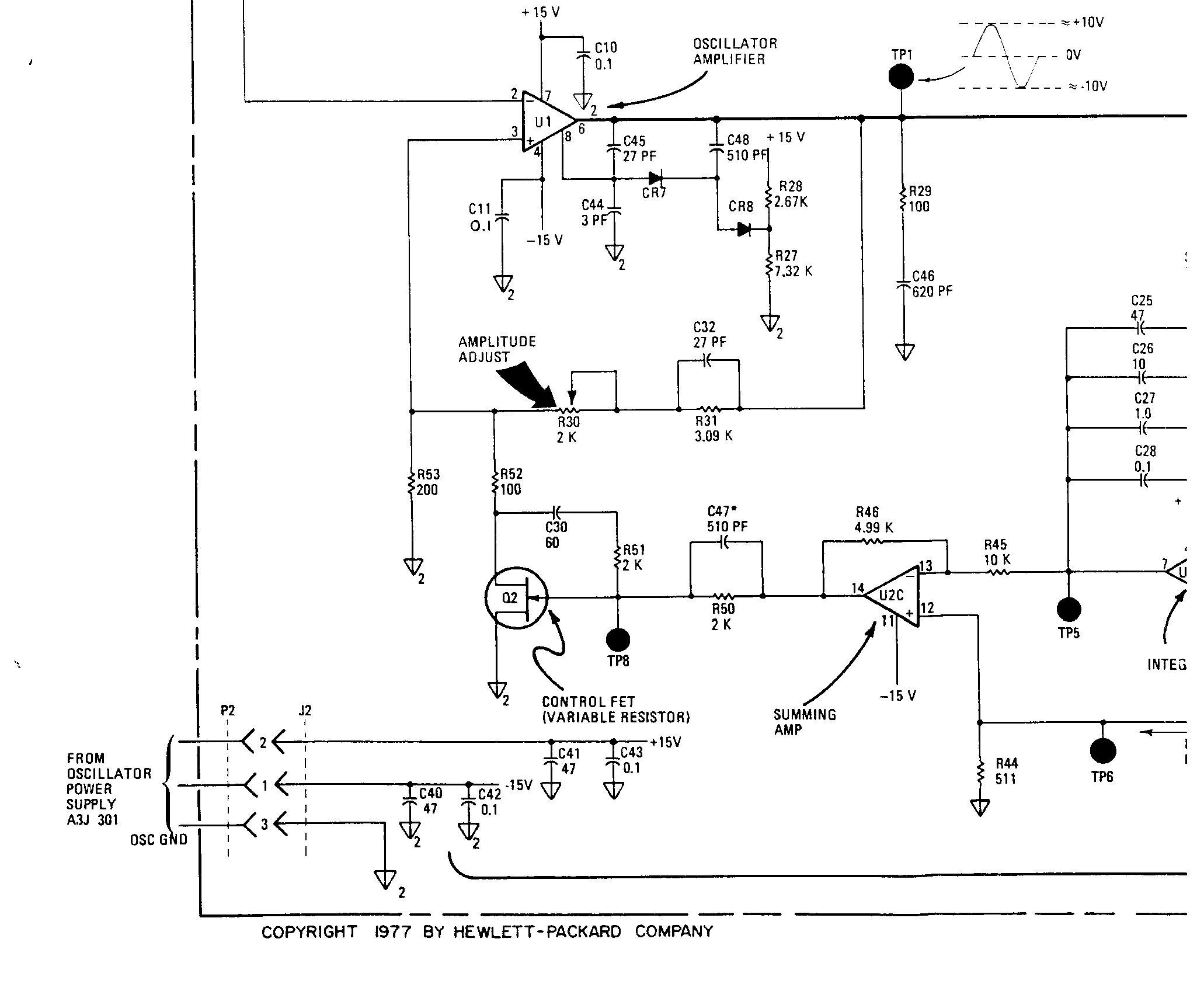HP 339A Mods & Upgrades
[h=[book=HP339a]%2$s[/book]
Introduction]%2$s[/h]
The HP339a was a state of the art (SOTA) distortion analyzer in the 1980s.
It is a full featured all-in-one product including a volt meter,
low-distortion oscillator, distortion analyzer, AM detector, and VU meter.
There was an in-depth analysis of low distortion oscillators
on DIYAudio on the following link:
<Low-disortion Audio-range Oscillator>
This was followed by a specific HP339a thread, linked here:
<HP339a>
This is a summary of those threads along with the links, conversations, and
posts, about the research and development that went into the suggested modifications to the venerable HP 339A.
[h=Outline]%2$s[/h]
[h=Why HP 339A?]%2$s[/h]
HP339A Post #78
Well, a stock 339A gives you a wide band ac voltmeter, an oscillator and analyzer. A stock one will do you pretty well as long as you have no interest in reading below .001%. The basic mods will do you just fine. The best bang for the dollar invested. But they are old and finding one in very good condition takes time.
An alternative is an ADC with FFT software and your PC. It will also cost about the same and is also accurate to .001% or -100dB. It isnt as flexible without adding input voltage ranging add-on and if you want to see below -100dB you can also add a notch filter.
And, then you can have both and use the residual output from the 339A built-in notch filter into an ADC/FFT.
[h= Affordable Quality Instrument for DIY Mods ]%2$s[/h]
From Post #1146:
The 339A is about the cheapest instrument that DIY'ers will ever be able to do simple mods to (parts, value changes and IC replacements) and get excellent results. However, next up the ladder of affordability might be the popular HP 8903_ or others? If the full potential can be realized in that one or other readily available used gear, what rewards will they bring? This little 339A exercise shows us there is a lot that can be had in refurbishing them for improved performance and that the fundamental design is sound.
[h=Wide range of frequencies and input voltages]%2$s[/h]
From Post #1577:
-- just change the IC's and a few caps and trimmers and you are done with the mods. Then just use its' own analyzer to tune the thd with the trimmers for a null. That's about it. The nice thing about the 339A is that it has a wide range of frequencies and it can be used as an rms voltmeter with db scales. The analyzer will accept a wide range of voltages on its input. It will give you a fast indication of the thd+n with a minimum of fuss and cost less than any other options.
We here got carried away with the oscillator and have been curious as to how low can we make it can go... far lower than the THD meter/analyzer part... but an indication well under .001 (-100dB) should show that you have a pretty good amp/preamp circuit.
[h=Accepts up to 300 Vrms on attenuated input]%2$s[/h]
[h=Similar to Dick Moore's project ]%2$s[/h]
From Post #1554:
For all those thinking of using an HP339A and want to improve it:
I just looked at a similar project by Dick Moore. He copied the 339A oscillator circuit and put it into another existing chassis. Didn't use the 339A analyzer section. If you go to his site, you will get a well written, detailed summary of what to do on the oscillator. -- RNMarsh
[h=Link to Dick Moore's Lab Pages]%2$s[/h]
Our colleague, Dick Moore passed away November 2015, he is missed by all whom he touched. Dick's moorepage.net and it's information now appear here as of
December, 2016):
https://www.tronola.com/moorepage/index.html
[h=Base line performance.]%2$s[/h]
From Post #980: Low Distortion Analyzer
[h=Stock 339A Performance Numbers -]%2$s[/h]
Being able to have a wide range of test freq is a nice convenience.
So far the complete HP339A system -- reading its own oscillator at almost stock (oscillator + analyzer distortion) - with just a tune up and changing the two null trimmers (using a 3580A spectrum analyzer on the output monitor port of the 339A) -- gives a noise floor of -145. Harmonics, H2 is -105 and H3 -130. Its a good beginning and its getting better! :-) Thx-RNMarsh
Intro to the 339A boards. Unmodded
1. Pic
2. Pic
3. Pic
4. Pic
5. Pic
[h=Modified HP339A Performance Numbers ]%2$s[/h]
[h=FFT Plots w/Test Equip ]%2$s[/h]
From Post #2156:
The 339A is a thd+N meter. The osc and analyzer spec is .0018% or better. That is a tick below the 0.2 mark on the 0-1 scale (-80dB =1).
After opamp and parts changes and upgrades, the thd+n is near the 0 mark -- well below -100dB. This is THD+N.
Using the 339A monitor output shows the two dominant harmonics, 2H at -106 dB and 3H at -110 dB. The top is -100 dB and 10 dB/div. and measured with shibasoku 725D analyzer ported to an HP 3580A Spectrum Analyzer to measure individual harmonic and noise levels. This is a compromise tuning for a wide range of freqs; For minimum thd+n at only one freq, it can be much lower:


[h=More Numbers from Modifications]%2$s[/h]
Chamberman reports the following from the HP339A Distortion Analyzer, post #681:
Well there was a bit more performance than I had expected left in the 339A's oscillator with those parts removed (see note below). My measurement feeding the 339A's oscillator into the Amber 3501 analyzer before removing them was .0006% THD+N. Then after removing the capacitors C32, C48, C45, C46, C16, C17,C14, C15 removed and C49 changed to 0.1u polypropylene, per David's post. The measurement on my Amber 3501 dropped to .00045% about a 2.5dB reduction. The 339A's internal distortion analyzer showed a somewhat smaller reduction dropping from .00075% before to .00065% after removing those parts. I should mention these measurements were with the 400Hz HP and 30kHz LP filters active.
If you install the LT1468 for U1 and LME49710 for U3 in the oscillator then you must remove the external compensation caps David listed for max performance. I've yet to replace U2 with a TL074 so there may be a bit more in it.
Note: Davada identified the mods in post #1184:
Don't forget to remove the dangling parts!(me)
[h=Disassembly and Cleaning]%2$s[/h]
[h=Things to be careful about]%2$s[/h]
Careful when making adjustments that you don't short the case of the Jfet.
It's very close to one of the trim pots and if it shorts it's toast.
Stability Build Before Modding:
1. Testing and Replacing power supply electrolytic capacitors.
2. Other Platform stability building.
Soldering Sockets:
1. Careful as the HP339A is a two layer board
with a via connecting one side to the other. This
shouldn't be a problem except after removing
an op amp and soldering a socket in it's place.
2. It is very easy for the solder to flow though
to the other side and connecting pad traces that shouldn't be connected. Don't ask me how
I know.
[h=Modifications]%2$s[/h]
Most bang for the buck.
Davada - Explains the HP339a configuration
and the limitations of the mods which are in
a different thread, aptly named HP339A:
[h=Output Level Pot]%2$s[/h]
Davada - Post #48:
Davada found the output level pot to be a source of distortion. You can
find the voltage level output pot for under $10 at Mouser or other suppliers.
The pot is a Bourns cermet type, p/n 51SADU25A15L.
The output level pot is easy to change. Loosen the screws on the shaft extender and spin the nuts off. 20 min tops. The pot shaft is longer than needed so you
have to cut it to proper length about 8 to10 mm.
[h=Oscillator and Pot change ]%2$s[/h]
From Post #45, #47 (HP339a):
If you wanted to do the minimum, just changing the oscillator opamp
(AD797 etc) and replace its control pot with a new multi-turn and add
another trim for the fixed resistor that is feedback on the control jFET (d-g)
with a multi-turn (for 2H only).
But, a must do is replace the output level pot. That pot introduces a lot of harmonic distortion. -- RNMarsh
[h=Most used oscillator change]%2$s[/h]
From Post #75 (HP339a):
The bottom of the board is completely exposed once the analyzer is opened up.
It's a bit tight from the top of the board but all your doing is inserting
components. Just remember to remove all the compensation and clamping
components around the op amp for the oscillator.
If you use an LT1468 the compensation is wrong and not needed.
There's is not much to go wrong. Just be careful when making adjustments
that you don't short the case of the Jfet. It's very close to one of the pots and if it shorts it's toast. --Davada
[h=FFT with These Mods]%2$s[/h]
From Post #83:
FFT at this point:

[h=A1 Board Oscillator Schematic]%2$s[/h]
Davada - Post #88 Schematic

[h=A1 Board Specific Mods]%2$s[/h]
From Post #86:
[h=The jFET feedback R51/2K.]%2$s[/h] Replace with 28 turn pot/trimmer. It is in series with a 60mfd cap (C30)..... together they go from jFET gate to its' drain. Replace C30 with 100mfd 105c bipolar.
[h=The Oscillator Amplitude Adjust pot (R30/2K)]%2$s[/h] Replace, as it's
old, has contact issues, and makes the adjustment difficult and 'touchy'.
[h=The output pot is R3 (10K). Replace.]%2$s[/h] Replace:
Bourns cermet, p/n 51SADU25A15L
[h=HP ID: A1U1]%2$s[/h] Replace Oscillator with Linear Technology OpAmp LT1468. These simple mods are all you need to do to have the level of THD shown.
[h=Notes and errata]%2$s[/h]
[h=Service/Test Notes ]%2$s[/h]
[h= PhotoCell LED Measurement]%2$s[/h]
Dick Moore wrote this up to help us
test the Photocells and see if they are
still good or not. Thank you Dick, R.I.P.
Link to Post#39
[h=Filter and Output Cleanup]%2$s[/h]
Here is some good stuff starting right
about here, link to Post#438
Basic Mumbo Jumbo
Hocus Pokus Dominatrix
Read up to about post #2300 in the low distortion analyzer thread.
Start: Photos before mods example
End: Photo after mods exemplary example
How to, that is what to do.
Parts
Resources
Work arounds
To do
To not do
[h=Brought to you by these fine folks at DIY Audio:]%2$s[/h]
[h= Davada ]%2$s[/h]
[h= Richiem, R.I.P. ]%2$s[/h]
[h= Special thanks to her Most Reverend Robin Moore]%2$s[/h]
[h= RNMarsh ]%2$s[/h]
[h= 1Audio ]%2$s[/h]
[h= Tronola]%2$s[/h]
[h= S.Lafferty]%2$s[/h]
[h= et al ]%2$s[/h]
[h= and a cast of 10s]%2$s[/h]
[h= ]%2$s[/h]
[h= on thousands of written pages]%2$s[/h]
[h= Boiled down for the average Joe by SyncTronX.]%2$s[/h]
[var]description|[book=HP339a]%2$s[/book] HP 339a Modification & Summary.[/var]
Introduction]%2$s[/h]
The HP339a was a state of the art (SOTA) distortion analyzer in the 1980s.
It is a full featured all-in-one product including a volt meter,
low-distortion oscillator, distortion analyzer, AM detector, and VU meter.
There was an in-depth analysis of low distortion oscillators
on DIYAudio on the following link:
<Low-disortion Audio-range Oscillator>
This was followed by a specific HP339a thread, linked here:
<HP339a>
This is a summary of those threads along with the links, conversations, and
posts, about the research and development that went into the suggested modifications to the venerable HP 339A.
[h=Outline]%2$s[/h]
[h=Why HP 339A?]%2$s[/h]
HP339A Post #78
Well, a stock 339A gives you a wide band ac voltmeter, an oscillator and analyzer. A stock one will do you pretty well as long as you have no interest in reading below .001%. The basic mods will do you just fine. The best bang for the dollar invested. But they are old and finding one in very good condition takes time.
An alternative is an ADC with FFT software and your PC. It will also cost about the same and is also accurate to .001% or -100dB. It isnt as flexible without adding input voltage ranging add-on and if you want to see below -100dB you can also add a notch filter.
And, then you can have both and use the residual output from the 339A built-in notch filter into an ADC/FFT.
[h= Affordable Quality Instrument for DIY Mods ]%2$s[/h]
From Post #1146:
The 339A is about the cheapest instrument that DIY'ers will ever be able to do simple mods to (parts, value changes and IC replacements) and get excellent results. However, next up the ladder of affordability might be the popular HP 8903_ or others? If the full potential can be realized in that one or other readily available used gear, what rewards will they bring? This little 339A exercise shows us there is a lot that can be had in refurbishing them for improved performance and that the fundamental design is sound.
[h=Wide range of frequencies and input voltages]%2$s[/h]
From Post #1577:
-- just change the IC's and a few caps and trimmers and you are done with the mods. Then just use its' own analyzer to tune the thd with the trimmers for a null. That's about it. The nice thing about the 339A is that it has a wide range of frequencies and it can be used as an rms voltmeter with db scales. The analyzer will accept a wide range of voltages on its input. It will give you a fast indication of the thd+n with a minimum of fuss and cost less than any other options.
We here got carried away with the oscillator and have been curious as to how low can we make it can go... far lower than the THD meter/analyzer part... but an indication well under .001 (-100dB) should show that you have a pretty good amp/preamp circuit.
[h=Accepts up to 300 Vrms on attenuated input]%2$s[/h]
[h=Similar to Dick Moore's project ]%2$s[/h]
From Post #1554:
For all those thinking of using an HP339A and want to improve it:
I just looked at a similar project by Dick Moore. He copied the 339A oscillator circuit and put it into another existing chassis. Didn't use the 339A analyzer section. If you go to his site, you will get a well written, detailed summary of what to do on the oscillator. -- RNMarsh
[h=Link to Dick Moore's Lab Pages]%2$s[/h]
Our colleague, Dick Moore passed away November 2015, he is missed by all whom he touched. Dick's moorepage.net and it's information now appear here as of
December, 2016):
https://www.tronola.com/moorepage/index.html
[h=Base line performance.]%2$s[/h]
From Post #980: Low Distortion Analyzer
[h=Stock 339A Performance Numbers -]%2$s[/h]
Being able to have a wide range of test freq is a nice convenience.
So far the complete HP339A system -- reading its own oscillator at almost stock (oscillator + analyzer distortion) - with just a tune up and changing the two null trimmers (using a 3580A spectrum analyzer on the output monitor port of the 339A) -- gives a noise floor of -145. Harmonics, H2 is -105 and H3 -130. Its a good beginning and its getting better! :-) Thx-RNMarsh
Intro to the 339A boards. Unmodded
1. Pic
2. Pic
3. Pic
4. Pic
5. Pic
[h=Modified HP339A Performance Numbers ]%2$s[/h]
[h=FFT Plots w/Test Equip ]%2$s[/h]
From Post #2156:
The 339A is a thd+N meter. The osc and analyzer spec is .0018% or better. That is a tick below the 0.2 mark on the 0-1 scale (-80dB =1).
After opamp and parts changes and upgrades, the thd+n is near the 0 mark -- well below -100dB. This is THD+N.
Using the 339A monitor output shows the two dominant harmonics, 2H at -106 dB and 3H at -110 dB. The top is -100 dB and 10 dB/div. and measured with shibasoku 725D analyzer ported to an HP 3580A Spectrum Analyzer to measure individual harmonic and noise levels. This is a compromise tuning for a wide range of freqs; For minimum thd+n at only one freq, it can be much lower:


[h=More Numbers from Modifications]%2$s[/h]
Chamberman reports the following from the HP339A Distortion Analyzer, post #681:
Well there was a bit more performance than I had expected left in the 339A's oscillator with those parts removed (see note below). My measurement feeding the 339A's oscillator into the Amber 3501 analyzer before removing them was .0006% THD+N. Then after removing the capacitors C32, C48, C45, C46, C16, C17,C14, C15 removed and C49 changed to 0.1u polypropylene, per David's post. The measurement on my Amber 3501 dropped to .00045% about a 2.5dB reduction. The 339A's internal distortion analyzer showed a somewhat smaller reduction dropping from .00075% before to .00065% after removing those parts. I should mention these measurements were with the 400Hz HP and 30kHz LP filters active.
If you install the LT1468 for U1 and LME49710 for U3 in the oscillator then you must remove the external compensation caps David listed for max performance. I've yet to replace U2 with a TL074 so there may be a bit more in it.
Note: Davada identified the mods in post #1184:
Don't forget to remove the dangling parts!(me)
[h=Disassembly and Cleaning]%2$s[/h]
[h=Things to be careful about]%2$s[/h]
Careful when making adjustments that you don't short the case of the Jfet.
It's very close to one of the trim pots and if it shorts it's toast.
Stability Build Before Modding:
1. Testing and Replacing power supply electrolytic capacitors.
2. Other Platform stability building.
Soldering Sockets:
1. Careful as the HP339A is a two layer board
with a via connecting one side to the other. This
shouldn't be a problem except after removing
an op amp and soldering a socket in it's place.
2. It is very easy for the solder to flow though
to the other side and connecting pad traces that shouldn't be connected. Don't ask me how
I know.

[h=Modifications]%2$s[/h]
Most bang for the buck.
Davada - Explains the HP339a configuration
and the limitations of the mods which are in
a different thread, aptly named HP339A:
[h=Output Level Pot]%2$s[/h]
Davada - Post #48:
Davada found the output level pot to be a source of distortion. You can
find the voltage level output pot for under $10 at Mouser or other suppliers.
The pot is a Bourns cermet type, p/n 51SADU25A15L.
The output level pot is easy to change. Loosen the screws on the shaft extender and spin the nuts off. 20 min tops. The pot shaft is longer than needed so you
have to cut it to proper length about 8 to10 mm.
[h=Oscillator and Pot change ]%2$s[/h]
From Post #45, #47 (HP339a):
If you wanted to do the minimum, just changing the oscillator opamp
(AD797 etc) and replace its control pot with a new multi-turn and add
another trim for the fixed resistor that is feedback on the control jFET (d-g)
with a multi-turn (for 2H only).
But, a must do is replace the output level pot. That pot introduces a lot of harmonic distortion. -- RNMarsh
[h=Most used oscillator change]%2$s[/h]
From Post #75 (HP339a):
The bottom of the board is completely exposed once the analyzer is opened up.
It's a bit tight from the top of the board but all your doing is inserting
components. Just remember to remove all the compensation and clamping
components around the op amp for the oscillator.
If you use an LT1468 the compensation is wrong and not needed.
There's is not much to go wrong. Just be careful when making adjustments
that you don't short the case of the Jfet. It's very close to one of the pots and if it shorts it's toast. --Davada
[h=FFT with These Mods]%2$s[/h]
From Post #83:
FFT at this point:

[h=A1 Board Oscillator Schematic]%2$s[/h]
Davada - Post #88 Schematic

[h=A1 Board Specific Mods]%2$s[/h]
From Post #86:
[h=The jFET feedback R51/2K.]%2$s[/h] Replace with 28 turn pot/trimmer. It is in series with a 60mfd cap (C30)..... together they go from jFET gate to its' drain. Replace C30 with 100mfd 105c bipolar.
[h=The Oscillator Amplitude Adjust pot (R30/2K)]%2$s[/h] Replace, as it's
old, has contact issues, and makes the adjustment difficult and 'touchy'.
[h=The output pot is R3 (10K). Replace.]%2$s[/h] Replace:
Bourns cermet, p/n 51SADU25A15L
[h=HP ID: A1U1]%2$s[/h] Replace Oscillator with Linear Technology OpAmp LT1468. These simple mods are all you need to do to have the level of THD shown.
[h=Notes and errata]%2$s[/h]
[h=Service/Test Notes ]%2$s[/h]
[h= PhotoCell LED Measurement]%2$s[/h]
Dick Moore wrote this up to help us
test the Photocells and see if they are
still good or not. Thank you Dick, R.I.P.
Link to Post#39
[h=Filter and Output Cleanup]%2$s[/h]
Here is some good stuff starting right
about here, link to Post#438
Basic Mumbo Jumbo
Hocus Pokus Dominatrix
Read up to about post #2300 in the low distortion analyzer thread.
Start: Photos before mods example
End: Photo after mods exemplary example
How to, that is what to do.
Parts
Resources
Work arounds
To do
To not do
[h=Brought to you by these fine folks at DIY Audio:]%2$s[/h]
[h= Davada ]%2$s[/h]
[h= Richiem, R.I.P. ]%2$s[/h]
[h= Special thanks to her Most Reverend Robin Moore]%2$s[/h]
[h= RNMarsh ]%2$s[/h]
[h= 1Audio ]%2$s[/h]
[h= Tronola]%2$s[/h]
[h= S.Lafferty]%2$s[/h]
[h= et al ]%2$s[/h]
[h= and a cast of 10s]%2$s[/h]
[h= ]%2$s[/h]
[h= on thousands of written pages]%2$s[/h]
[h= Boiled down for the average Joe by SyncTronX.]%2$s[/h]
[var]description|[book=HP339a]%2$s[/book] HP 339a Modification & Summary.[/var]
Total Comments 10
Comments
-
 Thanks for doing this Sync.
Thanks for doing this Sync.
Steve.Posted 29th November 2016 at 05:58 AM by srh 
-

Posted 4th December 2016 at 09:01 PM by anatech 
-

HP339A Mods Blog
You are most welcome. The gentlemen listed at
the end of the blog are those who put in the real
effort and the research and development. The
least that I could do it summarize their work.
Where I feel it important I'll try and link back
to the original discusson, trail, error, and debate.Posted 5th December 2016 at 06:32 AM by SyncTronX 
-

Posted 5th December 2016 at 12:29 PM by skidave 
-

Posted 5th December 2016 at 11:58 PM by SyncTronX 
-

Posted 6th December 2016 at 08:25 AM by miklos 
-

Posted 7th December 2016 at 05:41 AM by SyncTronX 
-

Posted 27th December 2016 at 03:50 PM by SyncTronX 
-
 thanks for this!
thanks for this!Posted 5th January 2017 at 09:50 AM by tschrama 
-

Posted 10th April 2017 at 06:36 AM by SyncTronX 




